<< Previous | Displaying results 4551-4600 of 6769 for "" | Next >>
Defendant Albert Speer making his closing statement in the Nuremberg courtroom.
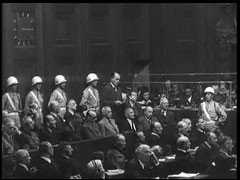
Defendant Julius Streicher is sworn in as a witness during the International Military Tribunal at Nuremberg.

This film clip shows translators in action at the Nuremberg trial. English, French, Russian, and German were the official languages of the Nuremberg trials. Interpreters provided simultaneous translations of the court proceedings which were then available to the trial participants via headphones.
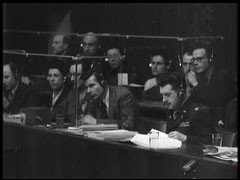
This film clip shows the use of headphones at the International Military Tribunal. English, French, Russian, and German were the official languages of the Nuremberg trials. Translators provided simultaneous translations of the proceedings. Each participant in the trial had a set of headphones.
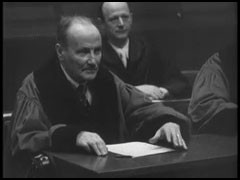
US prosecutor Thomas Dodd introduces the film compilation "Nazi Concentration Camps." At the end of the courtroom scene shown here, the lights are dimmed for the screening. The footage, filmed as Allied troops liberated the concentration camps, was presented in the courtroom on November 29, 1945, and entered as evidence in the trial.
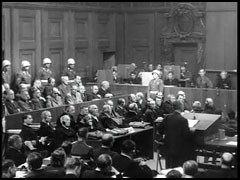
Clip from George Stevens' "The Nazi Concentration Camps." This German film footage was compiled as evidence and used by the prosecution at the Nuremberg trials.
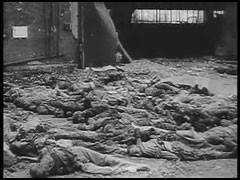
Clip from George Stevens' "The Nazi Concentration Camps." This German film footage was compiled as evidence and used by the prosecution at the Nuremberg trials.
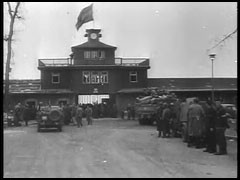
The film "Nazi Concentration Camps" was presented in the courtroom on November 29, 1945, and entered as evidence in the trial. It was filmed as Allied troops liberated the concentration camps. This clip shows the reactions of defendants and others in the courtroom following the screening of the film.
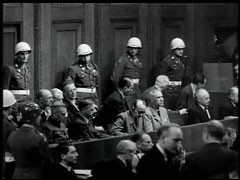
In this German propaganda newsreel, the former Mufti of Jerusalem, Hajj Amin al-Husayni, an Arab nationalist and prominent Muslim religious leader, meets Hitler for the first time. During the meeting, held in in the Reich chancellery, Hitler declined to grant al-Husayni’s request for a public statement--or a secret but formal treaty--in which Germany would: 1) pledge not to occupy Arab land, 2) recognize Arab striving for independence, and 3) support the “removal” of the proposed Jewish homeland in…
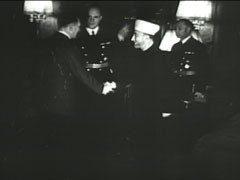
Hermann Göring recites the preamble to the Nuremberg Laws at the seventh Nazi Party Congress. The laws would define German citizenship by blood and forbade marriages between Germans and Jews. A special session of the Reichstag (German parliament) enacted the laws, marking an intensification of Nazi measures against Jews.
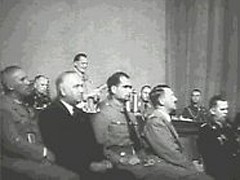
In this video introduction to The Nazi Olympics: Berlin 1936, American Jewish athlete Marty Glickman, US Holocaust Memorial Museum Director Sara J. Bloomfield, exhibition curator Susan Bachrach, and German Jewish athlete Gretel Bergmann reflect and remember the 1936 Olympic Games as more than history.
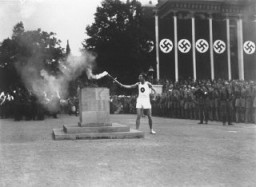
Soon after the Nazis assumed power in Germany, they launched a campaign to deprive Jews of their place in society. The effort began with an organized boycott of Jewish-owned businesses. Gangs arrested Jews, painted "Jews forbidden" onto shop windows, chanted antisemitic slogans, and blocked store entrances.
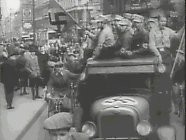
Learn about the Holocaust, the systematic, state-sponsored persecution and murder of six million Jews by the Nazi regime and its collaborators.
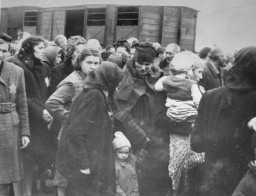
In October 1941, Romania, an ally of Nazi Germany, perpetrated mass killings of Jews in Odesa. Learn more about the Holocaust in Odesa and Ukraine.
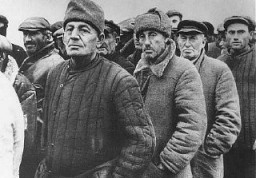
In May 1939, the German transatlantic liner St. Louis sailed from Germany to Cuba. Most of the passengers were Jews fleeing Nazi Germany. Learn more about the voyage.

An assembly point (the Umschlagplatz) in the Warsaw ghetto for Jews rounded up for deportation. Warsaw, Poland, 1942–43.
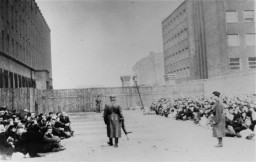
A group of young girls poses in a yard in the town of Ejszyszki (Eishyshok). The Jews of this shtetl were murdered by the Einsatzgruppen on September 21, 1941. Photo taken before September 1941.
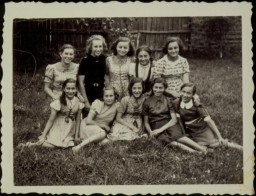
In this portrait, Helena Husserlova, wearing a Jewish badge, poses with her daughter Zdenka who is holding a teddy bear. The photograph was taken shortly before they were deported to Theresienstadt. Zdenka was born in Prague on February 6, 1939. On October 10, 1941, when Zdenka was just two and a half years old, her father was deported to the Lodz ghetto. He died there almost a year later, on September 23, 1942. Following his deportation, Helena and Zdenka returned to Helena's hometown to live with…
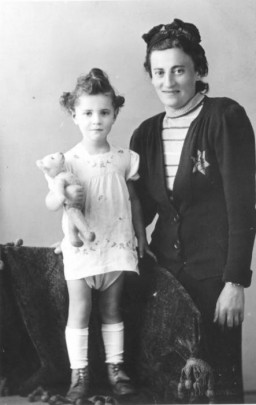
This photograph is a still from Soviet film footage of the liberation of Auschwitz. The film was made by the film unit of the First Ukrainian Front. Relief workers and Soviet soldiers lead child survivors of Auschwitz through a narrow passage between two barbed-wire fences. Standing next to the nurse and behind them (wearing white hats) are two sets of twin sisters. During the camp's years of operation, many children in Auschwitz were subjected to medical experiments by Nazi physician Josef Mengele.
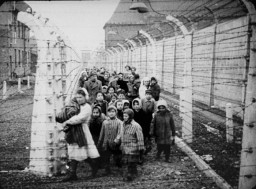
Prewar family portrait of members of the Danishevska family in Vilna, Lithuania, 1926–27. None of those pictured here survived the Holocaust.
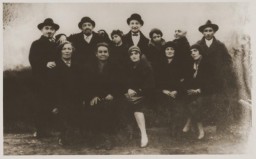
Klara Taussig and Ernst Brecher go on an outing in the Austrian countryside before their marriage. They later had a son, Heinz, who was born on August 29, 1932 in Graz, Austria. where his father was a merchant. After the Germans annexed Austria in 1938, Klara and Ernst sent Heinz to live with friends of an aunt in Zagreb. Heinz survived and eventually came to the United States on the Henry Gibbins, a military troop transport. Klara and Ernst died in the concentration camps. Photograph taken…
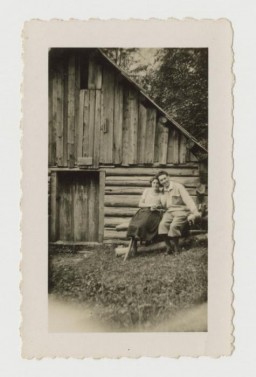
Holocaust survivor Frank Liebermann has a conversation with his teddy bear. Germany, 1933–35. On Frank Liebermann’s first day of school in Gleiwitz, Germany, in 1935, he reported to one of the few small classrooms set aside for Jews. After school, he rushed home to avoid antisemitic attacks. In 1936, it got worse. Anti-Jewish laws now banned Frank from playgrounds and swimming pools. The family decided it was time to leave and applied for US visas. They were lucky. In October 1938, the…
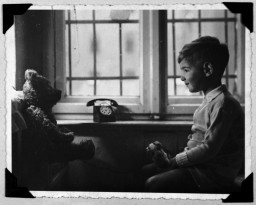
Benjamin Kedar (born Villiam Krausz) sits with a doll and a teddy bear shortly before his family went into hiding. Villiam's parents married in Prague and settled in Nitra, Slovakia. They worked as physicians. They had a daughter, Helen, in 1934, and Villiam in 1938. In 1942 the family relocated to a nearby village until September 1944. At that point, they went into hiding with Slovak peasants to avoid deportation to Auschwitz. Villiam, his sister, and his parents survived the…
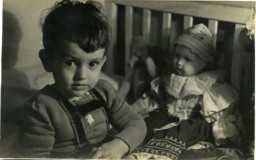
Robert Coopman was born in the Netherlands in September 1940. This 1941 photograph shows Robert holding a telephone while sitting next to a teddy bear. He and his parents lived in Amsterdam where his father was a salesman and bookkeeper. In July 1942, fearing for their safety, Robert's parents placed him in hiding with the Viejou family in Naarden. He was less than two years old. He lived as a member of the household until August 1944, when a neighbor betrayed them. Robert was …
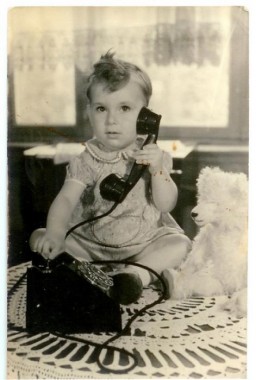
Trench warfare is one of the iconic symbols of World War I. This photograph shows British troops carrying boards over a support line trench at night during fighting on the western front. Cambrai, France, January 12, 1917.
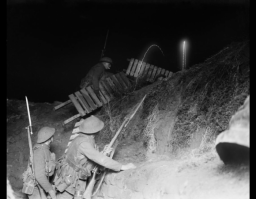
Herta Oberheuser was a physician at the Ravensbrück concentration camp. She performed medical experiments. She was found guilty of performing sulfanilamide experiments, bone, muscle, and nerve regeneration and bone transplantation experiments on humans, as well as of sterilizing prisoners. This portrait of Herta Oberheuser was taken when she was a defendant in the Medical Case Trial at Nuremberg.
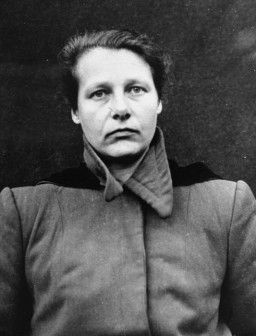
Oskar Schindler plants a tree on the Avenue of the Righteous Among the Nations at Yad Vashem. The Righteous Among the Nations are non-Jewish invididuals who have been honored by Yad Vashem, Israel's Holocaust memorial, for risking their lives to aid Jews during the Holocaust.
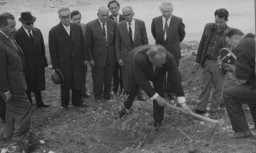
Scene during a visit by SS officer Theodor Eicke to the Lichtenburg camp in March 1936. Lichtenburg was one of the first concentration camps established in Germany were established soon after Hitler's appointment as chancellor in January 1933. When SS chief leader Heinrich Himmler centralized the administration of the concentration camps and formalized the camp system, he chose SS Lieutenant General Theodor Eicke for the task. Himmler appointed him Inspector of Concentration Camps, a new section of the…
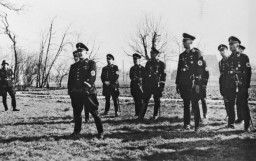
View of the charred remains of Jewish victims burned by the Germans near the Maly Trostinets concentration camp. Photograph taken ca. 1944. In the fall of 1943, the Germans destroyed the Minsk ghetto. The SS deported some Jews from Minsk to the Sobibor killing center, and killed about 4,000 remaining Jews at Maly Trostinets.
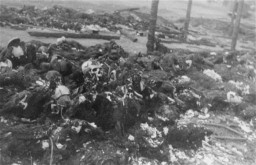
25th Nazi propaganda slide for a Hitler Youth educational presentation in the mid-1930s. The presentation was entitled "5000 years of German Culture." This slide references Lebensraum (the need for living space) in German history: "Wachsende Volkszahl im fargen Nordland zwang neuen Lebensraum zu suchen. Das innerlich morsche Römerreich bricht im Ansturm der Germanen zusammen." Translated as: "Growing numbers of people in Nordland were forced to look for a new habitat. The inwardly…

Close-up of corpses piled in the crematorium mortuary in the newly liberated Dachau concentration camp. Dachau, Germany, May 1945. This image is among the commonly reproduced and distributed, and often extremely graphic, images of liberation. These photographs provided powerful documentation of the crimes of the Nazi era.
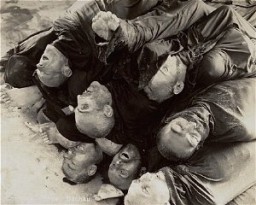
View of the main street of the Nordhausen concentration camp, outside of the central barracks (Boelke Kaserne), where the bodies of prisoners have been laid out in long rows. Nordhausen, Germany, April 13–14, 1945. This image is among the commonly reproduced and distributed, and often extremely graphic, images of liberation. These photographs provided powerful documentation of the crimes of the Nazi era.
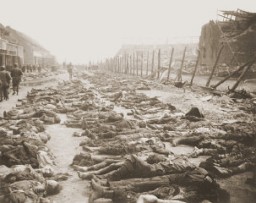
German civilians under US military escort are forced to view a wagon piled with corpses in the newly liberated Buchenwald concentration camp. Buchenwald, Germany, April 16, 1945.
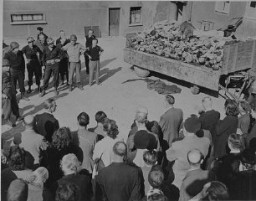
A wagon is piled with the bodies of victims of the Buchenwald concentration camp. Photograph taken following the liberation of the camp. The 6th Armored Division overran the camp on April 11, 1945. Buchenwald, Germany, April 11–May 1945.
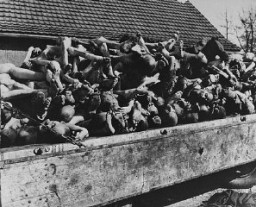
Former prisoners of the "little camp" in Buchenwald stare out from the wooden bunks in which they slept three to a "bed." Elie Wiesel is pictured in the second row of bunks, seventh from the left, next to the vertical beam. Abraham Hipler is pictured in the second row, fourth from the left. The man on the third bunk from the bottom, third from the left, is Ignacz (Isaac) Berkovicz. [He has also been identified as Abraham Baruch.] Michael Nikolas Gruner, originally from Hungary, is pictured on the bottom…
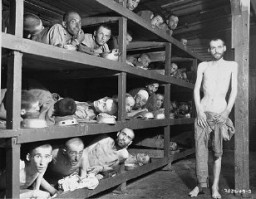
The bodies of former prisoners are stacked outside the crematorium in the newly liberated Buchenwald concentration camp. Buchenwald, Germany, April 23, 1945. This image is among the commonly reproduced and distributed, and often extremely graphic, images of liberation. These photographs provided powerful documentation of the crimes of the Nazi era.
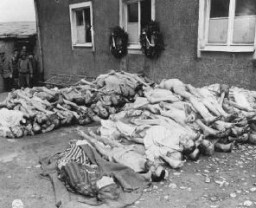
A wagon is piled high with the bodies of victims of the Buchenwald concentration camp. Photograph taken following the liberation of the camp. Buchenwald, Germany, April 16, 1945.
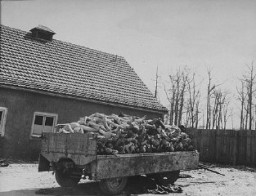
The charred corpse of a prisoner killed by the SS in a barn just outside of Gardelegen. The SS guards locked the prisoners, who were on a death march from the Dora-Mittelbau camp, in a barn, which was then set ablaze. Gardelegen, Germany, April 16, 1945. This image is among the commonly reproduced and distributed, and often extremely graphic, images of liberation. These photographs provided powerful documentation of the crimes of the Nazi era.
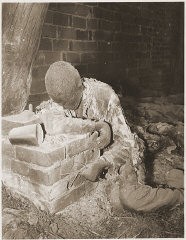
The charred remains of former prisoners in two crematoria ovens in the newly liberated Buchenwald concentration camp. Buchenwald, Germany, April 14, 1945. This image is among the commonly reproduced and distributed, and often extremely graphic, images of liberation. These photographs provided powerful documentation of the crimes of the Nazi era.
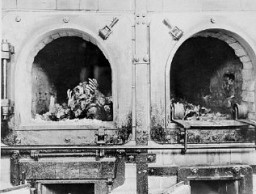
Two ovens inside the crematorium at the Dachau concentration camp. Dachau, Germany, July 1, 1945. This image is among the commonly reproduced and distributed images of liberation. These photographs provided powerful documentation of the crimes of the Nazi era.
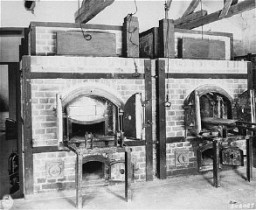
A pile of corpses in the newly liberated Dachau concentration camp. Dachau, Germany, April 29-May 1945. This image is among the commonly reproduced and distributed, and often extremely graphic, images of liberation. These photographs provided powerful documentation of the crimes of the Nazi era.
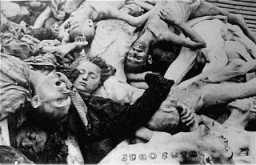
The bodies of former prisoners are piled outside the crematorium at the newly liberated Dachau concentration camp. Dachau, Germany, April–May 1945. This image is among the commonly reproduced and distributed, and often extremely graphic, images of liberation. These photographs provided powerful documentation of the crimes of the Nazi era.
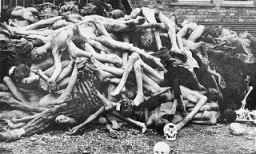
Cover to György Beifeld's album, featuring a road sign with the Hungarian Labor Service company number 109/13 posted in a muddy wasteland. The Jewish labor servicemen were forced to construct roads on these muddy fields to accommodate the advance of the Hungarian 2nd Army toward the Don River.
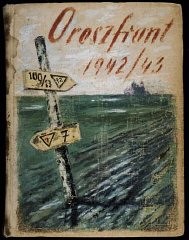
In a take-off of travel posters advertising peaceful vacation spots, Beifeld draws a picture of a Hungarian military tent pitched next to a tree on which a bird is cheerfully chirping. Next to the tent the artist writes "Peaceful Surroundings" but above, a Soviet bomber releases a bomb aimed at the tent. [Photograph #58022]
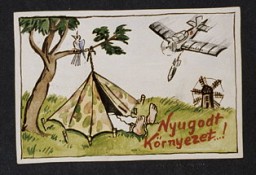
In 1942, seven-year-old Inge Auerbacher was deported with her parents to the Theresienstadt ghetto. She brought along this doll, named “Marlene” after German actress Marlene Dietrich, which her grandmother had given her. It would remain with Inge throughout her three years of imprisonment in the ghetto.
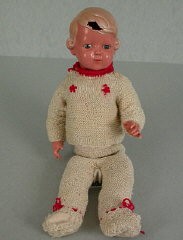
A hand-tinted photograph of Frieda Greinegger and Julian Noga as a young couple. The two had met when Julian, a forced laborer from Poland, arrived at the Greinegger farm in northern Austria. In 1941, the Gestapo sent both to concentration camps after learning of their forbidden friendship. Place uncertain, after 1945.
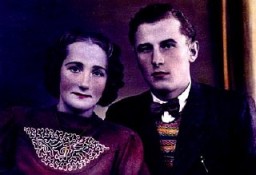
Frieda Greinegger during a family outing to a park in the mid-1930s. Frieda would later spend almost two years in the Ravensbrück concentration camp as punishment for consorting with a Polish forced laborer, Julian Noga. Austria, ca. 1935.
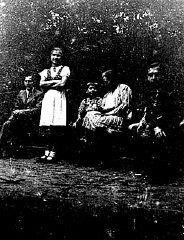
The Greinegger family, shown here in a formal portrait, were prosperous farmers in northern Austria. During World War II, the son died as a soldier in the German army. The second youngest daughter, Frieda, spent almost two years in Ravensbrück concentration camp for consorting with a Polish forced laborer, Julian Noga. Frieda and Julian married after the war. Place and date of photograph uncertain.
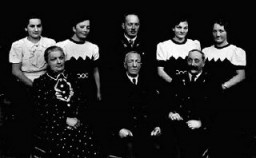
Two French partisans, Missak Manouchian (left) and Wolf Wajsbrot (right), who belonged to the French armed resistance group Francs-Tireurs et Partisans. They were executed by firing squad on February 21, 1944. Paris, France, February, 1944.

Fritz and Ida Lang, Jewish proprietors of a dry goods store in Lambsheim, posed for this picture around 1934. In the early 1940s, Nazi authorities deported the Langs and their young daughter, Freya, to detention camps in France. Ida died after deportation to Auschwitz. Fritz survived and reunited with his daughter in 1946. Lambsheim, Germany, ca. 1934.
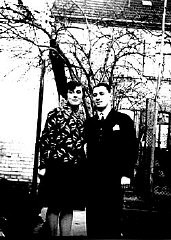
We would like to thank Crown Family Philanthropies, Abe and Ida Cooper Foundation, the Claims Conference, EVZ, and BMF for supporting the ongoing work to create content and resources for the Holocaust Encyclopedia. View the list of donor acknowledgement.